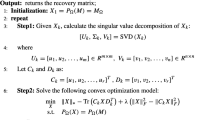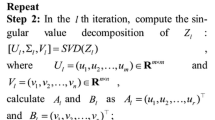Abstract
We consider the problem of modeling data matrices with locally low-rank (LLR) structure, a generalization of the popular low-rank structure widely used in a variety of real-world application domains ranging from medical imaging to recommendation systems. While LLR modeling has been found to be promising in real-world application domains, limited progress has been made on the design of scalable algorithms for such structures. In this paper, we consider a convex relaxation of LLR structure and propose an efficient algorithm based on dual projected gradient descent (D-PGD) for computing the proximal operator. While the original problem is non-smooth, so that primal (sub)gradient algorithms will be slow, we show that the proposed D-PGD algorithm has geometrical convergence rate. We present several practical ways to further speed up the computations, including acceleration and approximate SVD computations. With experiments on both synthetic and real data from MRI (magnetic resonance imaging) denoising, we illustrate the superior performance of the proposed D-PGD algorithm compared to several baselines.










Similar content being viewed by others
References
Banerjee A, Chen S, Fazayeli F, Sivakumar V (2014) Estimation with norm regularization. In: Ghahramani Z, Welling M, Cortes C, Lawrence ND, Weinberger KQ (eds) Advances in neural information processing systems 27. Curran Associates, Inc., pp 1556–1564
Beck A, Teboulle M (2009) A fast iterative shrinkage-thresholding algorithm for linear inverse problems. SIAM J Imaging Sci 2(1):183–202
Bertsekas DP (1999) Nonlinear programming. Athena Scientific, Belmont
Boyd S, Parikh N, Chu E, Peleato B, Eckstein J (2010) Distributed optimization and statistical learning via the alternating direction method of multipliers. Found Trends Mach Learn 3(1):1–122
Cai J-F, Candès EJ, Shen Z (2010) A singular value thresholding algorithm for matrix completion. SIAM J Optim 20(4):1956–1982
Candès EJ, Recht B (2009) Exact matrix completion via convex optimization. Found Comput Math 9(6):717–772
Candès EJ, Sing-long CA, Trzasko JD (2013) Unbiased risk estimates for singular value thresholding and spectral estimators. IEEE Trans Signal Process 61(19):4643–4657
Chen S, Banerjee A (2016) Structured matrix recovery via the generalized dantzig selector. In: Lee DD, Sugiyama M, Luxburg UV, Guyon I, Garnett R (eds) Advances in neural information processing systems 29. Curran Associates Inc., New York, pp 3252–3260
Chen X, Tseng P (2003) Non-interior continuation methods for solving semidefinite complementarity problems. Math Program 95(3):431–474
Donoho D, Gavish M (2014) Minimax risk of matrix denoising by singular value thresholding. Ann Stat 42(6):2413–2440
Goud S, Hu Y, Jacob M (2010) Real-time cardiac MRI using low-rank and sparsity penalties. In: ISBI, pp. 988–991
Gunasekar S, Banerjee A, Ghosh J (2015) Unified view of matrix completion under general structural constraints. Adv Neural Inf Process Syst 28:1180–1188
Haldar JP, Liang ZP (2010) Spatiotemporal imaging with partially separable functions: a matrix recovery approach. In: ISBI, pp. 716–719
Hoffman AJ (1952) On approximate solutions of systems of linear inequalities. J Res Natl Bur Stand 49(4):263–265
Horn RA, Johnson CR (1985) Matrix analysis, vol 169. Cambridge University Press, Cambridge
Koren Y (2008) Factorization meets the neighborhood: a multifaceted collaborative filtering model. In: Proceedings of the 14th ACM SIGKDD international conference on knowledge discovery and data mining, pp. 426–434
Lee J, Kim S, Lebanon G, Singer Y, Bengio S (2016) Llorma: local low-rank matrix approximation. J Mach Learn Res 17(15):1–24
Lin Z, Liu R, Su Z (2011) Linearized alternating direction method with adaptive penalty for low-rank representation. Adv Neural Inf Process Syst 24(1):1–9
Luo ZQ, Tseng P (1993) Error bounds and convergence analysis of feasible descent methods: a general approach. Ann Oper Res 46–47(1):157–178
Ma S, Goldfarb D, Chen L (2011) Fixed point and bregman iterative methods for matrix rank minimization. Math Program 128(1):321–353
Moreau JJ (1962) Decomposition orthogonale d’un espace hilbertien selon deux cones mutuellement polaires. Comptes Rendus de l’Académie des Sci 255:238–240
Negahban S, Wainwright MJ (2011) Estimation of (near) low-rank matrices with noise and high-dimensional scaling. Ann Stat 39(2):1069–1097
Nesterov Y (2004) Introductory lectures on convex optimization : a basic course, applied optimization. Kluwer Academic Publ, Boston
O’Donoghue B, Candés E (2015) Adaptive restart for accelerated gradient schemes. Found Comput Math 15(3):715–732
Parikh N, Boyd S (2014) Proximal algorithms. Found Trends Optim 1(3):127–239
Peng Z, Yan M, Yin W (2013) Parallel and distributed sparse optimization. In: 2013 Asilomar conference on signals, systems and computers, pp. 659–646
Recht B, Fazel M, Parrilo PA (2010) Guaranteed minimum-rank solutions of linear matrix equations via nuclear norm minimization. SIAM Rev 52(3):471–501
Rockafellar RT (1970) Convex analysis. Princeton University Press, Princeton
Toh KC, Yun S (2010) An accelerated proximal gradient algorithm for nuclear norm regularized linear least squares problems. Pac J Optim 6:615–640
Trzasko JD (2013) Exploiting local low-rank structure in higher-dimensional mri applications. In: Proceedings of SPIE, vol 8858, pp 885821–885828
Trzasko JD, Mostardi PM, Riederer SJ, Manduca A (2013) Estimating t1 from multichannel variable flip angle SPGR sequences. Magn Reson Med 69(6):1787–1794
Trzasko J, Manduca A (2011) Local versus global low-rank promotion in dynamic MRI series reconstruction. In: ISMRM, vol 24, p 4371
Watson GA (1992) Characterization of the subdifferential of some matrix norms. Linear Algebra Appl 170(C):33–45
Yao Q, Kwok JT (2015) Colorization by patch-based local low-rank matrix completion. In: Proceedings of the twenty-ninth AAAI conference on artificial intelligence, AAAI’15. AAAI Press, pp. 1959–1965
Zhou Z, So AM-C (2015) A unified approach to error bounds for structured convex optimization problems, pp. 1–32. arXiv:1512.03518
Acknowledgements
The research was supported by NSF grants IIS-1563950, IIS-1447566, IIS-1447574, IIS-1422557, CCF-1451986, CNS- 1314560, IIS-0953274, IIS-1029711, CCF:CIF:Small:1318347, NASA grant NNX12AQ39A, “Mayo Clinic Discovery Translation Program”, and gifts from Adobe, IBM, and Yahoo.
Author information
Authors and Affiliations
Corresponding author
Additional information
Publisher's Note
Springer Nature remains neutral with regard to jurisdictional claims in published maps and institutional affiliations.
Rights and permissions
About this article
Cite this article
Gu, Q., Trzasko, J.D. & Banerjee, A. Scalable algorithms for locally low-rank matrix modeling. Knowl Inf Syst 61, 1457–1484 (2019). https://doi.org/10.1007/s10115-018-1320-9
Received:
Revised:
Accepted:
Published:
Issue Date:
DOI: https://doi.org/10.1007/s10115-018-1320-9




